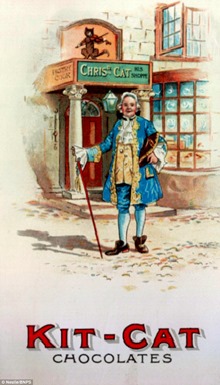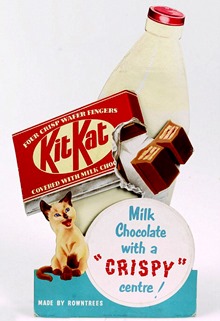 Use of the name Kit Kat or Kit Cat for a type of food goes back to the 18th century, when mutton pies known as a Kit-Kat were served at meetings of the political Kit-Cat Club in London.
Use of the name Kit Kat or Kit Cat for a type of food goes back to the 18th century, when mutton pies known as a Kit-Kat were served at meetings of the political Kit-Cat Club in London.
The origins of what is now known as the Kit Kat brand go back to 1911, when Rowntree’s, a confectionery company based in York in the United Kingdom, trademarked the terms Kit Cat and Kit Kat. Although the terms were not immediately used, the first conception of the Kit Kat appeared in the 1920s, when Rowntree launched a brand of boxed chocolates entitled Kit Cat. This continued into the 1930s, when Rowntree’s shifted focus and production onto its Black Magic and Dairy Box brands. With the promotion of alternative  products the Kit Cat brand decreased and was eventually discontinued. The original four-finger bar was developed after a worker at Rowntree’s York Factory put a suggestion in a recommendation box for a snack that “a man could take to work in his pack”. The bar launched on 29 August 1935, under the title of Rowntree’s Chocolate Crisp (priced at 2d), and was sold in London and throughout Southern England.
products the Kit Cat brand decreased and was eventually discontinued. The original four-finger bar was developed after a worker at Rowntree’s York Factory put a suggestion in a recommendation box for a snack that “a man could take to work in his pack”. The bar launched on 29 August 1935, under the title of Rowntree’s Chocolate Crisp (priced at 2d), and was sold in London and throughout Southern England.
 The product’s official title of Rowntree’s Chocolate Crisp was renamed Kit Kat Chocolate Crisp in 1937, the same year that Kit Kat began to incorporate “Break” into its recognisable advertising strategy. The colour scheme and first flavour variation to the brand came in 1942, owing to World War II, when food shortages prompted an alteration in the recipe. The flavour of Kit Kat was changed to dark chocolate; the packaging abandoned its Chocolate Crisp title, and was adorned in blue.[5] After the war the title was altered to Kit Kat and resumed its original milk recipe and red packaging.
The product’s official title of Rowntree’s Chocolate Crisp was renamed Kit Kat Chocolate Crisp in 1937, the same year that Kit Kat began to incorporate “Break” into its recognisable advertising strategy. The colour scheme and first flavour variation to the brand came in 1942, owing to World War II, when food shortages prompted an alteration in the recipe. The flavour of Kit Kat was changed to dark chocolate; the packaging abandoned its Chocolate Crisp title, and was adorned in blue.[5] After the war the title was altered to Kit Kat and resumed its original milk recipe and red packaging.
 Following on from its success in the United Kingdom, in the 1940s Kit Kat was exported to Canada, South Africa, Ireland, Australia, and New Zealand. In 1958, Donald Gilles, the executive at JWT Orland, created the iconic advertising line “Have a Break, Have a Kit Kat”. The brand further expanded in the 1970s when Rowntree created a new distribution factory in Germany to meet European demand, and established agreements to distribute the brand in the USA and Japan through the Hershey and Fujiya companies, respectively. In June 1988 Nestlé acquired Kit Kat through the purchase of Rowntree’s. This gave Nestlé global control over the brand, except in the US, and production and distribution increased with new facilities in Japan and additional manufacturing operations set up in Malaysia, India and China.[2]
Following on from its success in the United Kingdom, in the 1940s Kit Kat was exported to Canada, South Africa, Ireland, Australia, and New Zealand. In 1958, Donald Gilles, the executive at JWT Orland, created the iconic advertising line “Have a Break, Have a Kit Kat”. The brand further expanded in the 1970s when Rowntree created a new distribution factory in Germany to meet European demand, and established agreements to distribute the brand in the USA and Japan through the Hershey and Fujiya companies, respectively. In June 1988 Nestlé acquired Kit Kat through the purchase of Rowntree’s. This gave Nestlé global control over the brand, except in the US, and production and distribution increased with new facilities in Japan and additional manufacturing operations set up in Malaysia, India and China.[2]
The Hershey Company has a licence to produce Kit Kat bars in the United States which dates from 1970, when Hershey executed a licensing agreement with Rowntree. Nestlé, which has a substantial  presence in the US, had to honour the licensing agreement when it bought Rowntree in 1988 which allowed Hershey to retain the Kit Kat licence so long as Hershey was not sold. As Kit Kat is one of Hershey’s top five brands in the US market, the Kit Kat licence was a key factor in Hershey’s failed attempt to attract a serious buyer in 2002.
presence in the US, had to honour the licensing agreement when it bought Rowntree in 1988 which allowed Hershey to retain the Kit Kat licence so long as Hershey was not sold. As Kit Kat is one of Hershey’s top five brands in the US market, the Kit Kat licence was a key factor in Hershey’s failed attempt to attract a serious buyer in 2002.
Variants in the traditional chocolate bar first appeared in 1996 when Kit Kat Orange, the first flavour variant, was introduced in the United Kingdom. Its success was followed by several varieties including mint and caramel, and in 1999 Kit Kat Chunky was launched and received favourably by international consumers. Variations on the traditional Kit Kat have continued to develop throughout the 2000s. In 2000, Nestlé acquired Fujiya’s share of the brand in Japan, and also expanded its marketplace in Japan, Russia, Turkey, and Venezuela, in addition to  markets in Eastern and Central Europe. Throughout the decade Kit Kat has introduced dozens of flavours and line extensions within specific consumer markets, and celebrated its 75th anniversary on 10 October 2009.
markets in Eastern and Central Europe. Throughout the decade Kit Kat has introduced dozens of flavours and line extensions within specific consumer markets, and celebrated its 75th anniversary on 10 October 2009.
The traditional bar has four fingers which each measure approximately 1 centimetre (0.4 in) by 9 centimetres (3.5 in). A two-finger bar was launched in the 1930s, and has remained the company’s best-selling biscuit brand ever since. The 1999 Kit Kat Chunky (known as Big Kat and Kit Kat Extra Crispy in the US) has one large finger approximately 2.5 centimetres (1 in) wide. Kit Kat bars contain varying numbers of fingers depending on the market, ranging from the half-finger sized Kit Kat Petit in Japan, to the three-fingered variants in Arabia, to the twelve-finger family-size bars in Australia and France. Kit Kat bars are sold individually and in bags, boxes and multi-packs. In Ireland, France, the UK and America Nestlé also produces a Kit Kat ice cream, and in Australia and Malaysia, Kit Kat Drumsticks.
In 2010, a new £5 million manufacturing line was opened by Nestlé in York. This will produce more than a billion Kit Kat bars each year.
Text from Wikipedia


Der var det jo en liten Tiger også. ❤
Kit Kat er vel kanskje forløperen til vår norske Kvikk Lunsj?
LikeLike
Kvikk Lunch kom faktisk først 🙂
LikeLiked by 1 person
Oooops! Husket feil. KItKat ble lansert i 1911 og Kvikk Lunsj i 1937. Da hermet vel Freia litt da tenker jeg, selv om KL ble lanser som den første virkelige tursjokoladen fremfor noen, og regnes vel som den ultimate tursjokoladen enda 😉
LikeLiked by 1 person
Rowntree’s original four-finger bar was launched in 1935. The Norwegian equivalent has been produced since 1937: Kvikk Lunch, later spelled Kvikk Lunsj is consequently a copy! So sorry fellow countrymen, our “original” isn’t after all.
Kvikk Lunsj is Norway’s best selling chocolate and has become quite an icon. It has always been promoted as an ideal companion for hiking and skiing in the woods and in the mountains. It would be unthinkable as part of a lunch at work or at school.
Harald
LikeLiked by 1 person
So they beat us there 😉 🙂
LikeLiked by 1 person
[…] https://recipereminiscing.wordpress.com/2016/12/09/the-history-of-kitkat/ […]
LikeLiked by 1 person
What an informative post! Thanks for sharing it with us at Fiesta Friday!
LikeLiked by 1 person
A little food history is always entertaining 😉
LikeLiked by 1 person